UMKC Speech 1: Guide to Ethical Source Use and Citations
VerifiedAdded on 2022/12/21
|5
|856
|68
Presentation
AI Summary
This presentation, created for a DISC 100 assignment at a university, addresses the critical topics of ethical source use and plagiarism prevention. The presentation, structured as a short video guide, covers the concepts of plagiarism, its implications, and the importance of ethical data source selection. It emphasizes that plagiarism involves using others' work without acknowledgment and the negative consequences, including reputational damage and academic penalties. The presentation also explores the significance of reliable sources for maintaining study integrity and avoiding biased outcomes. To mitigate plagiarism and ensure academic integrity, the guide recommends paraphrasing, proper citation, and the use of direct quotes. The presentation concludes by reinforcing the need for these practices to maintain academic integrity and achieve unbiased research outcomes. References are provided for further information.
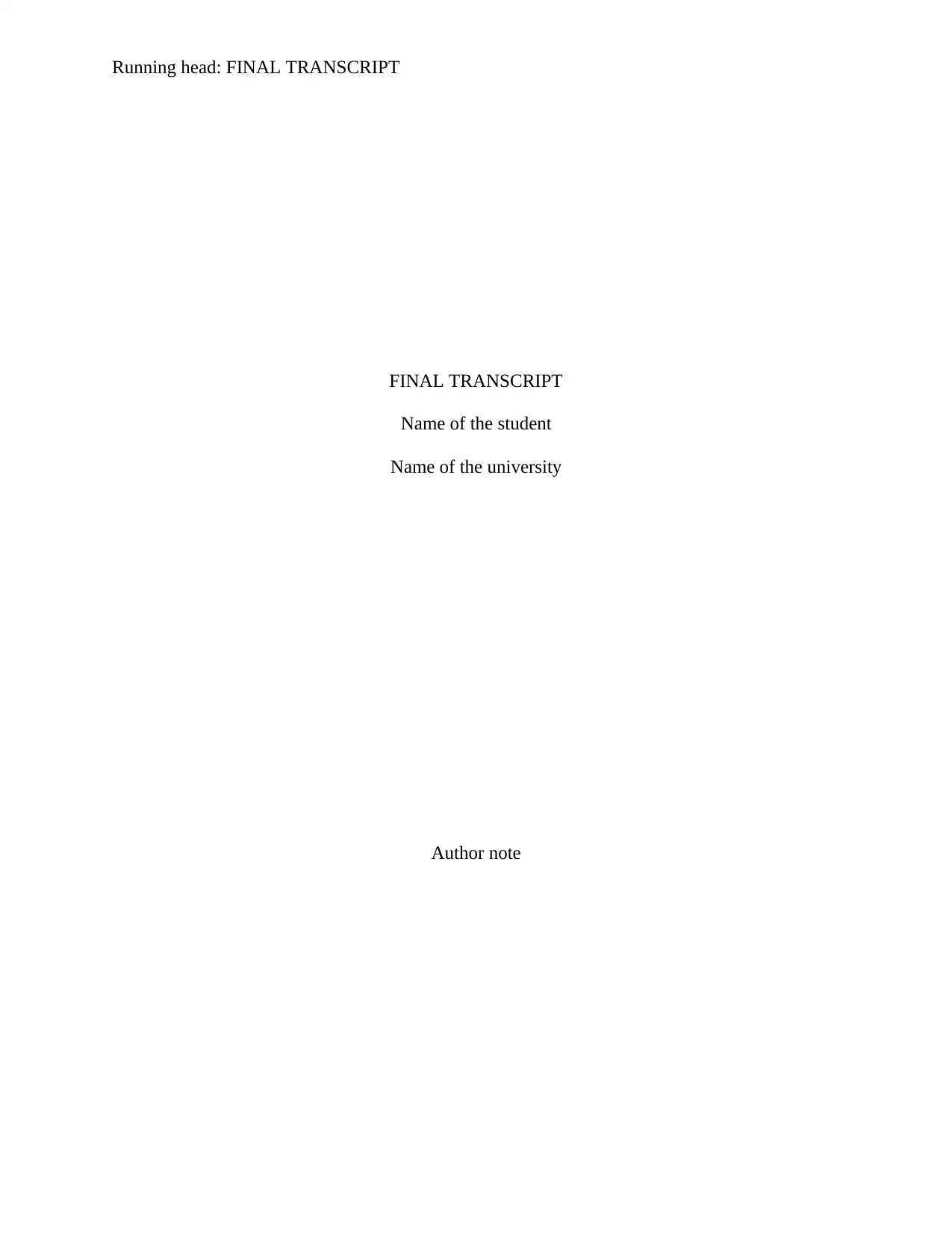
Running head: FINAL TRANSCRIPT
FINAL TRANSCRIPT
Name of the student
Name of the university
Author note
FINAL TRANSCRIPT
Name of the student
Name of the university
Author note
Paraphrase This Document
Need a fresh take? Get an instant paraphrase of this document with our AI Paraphraser
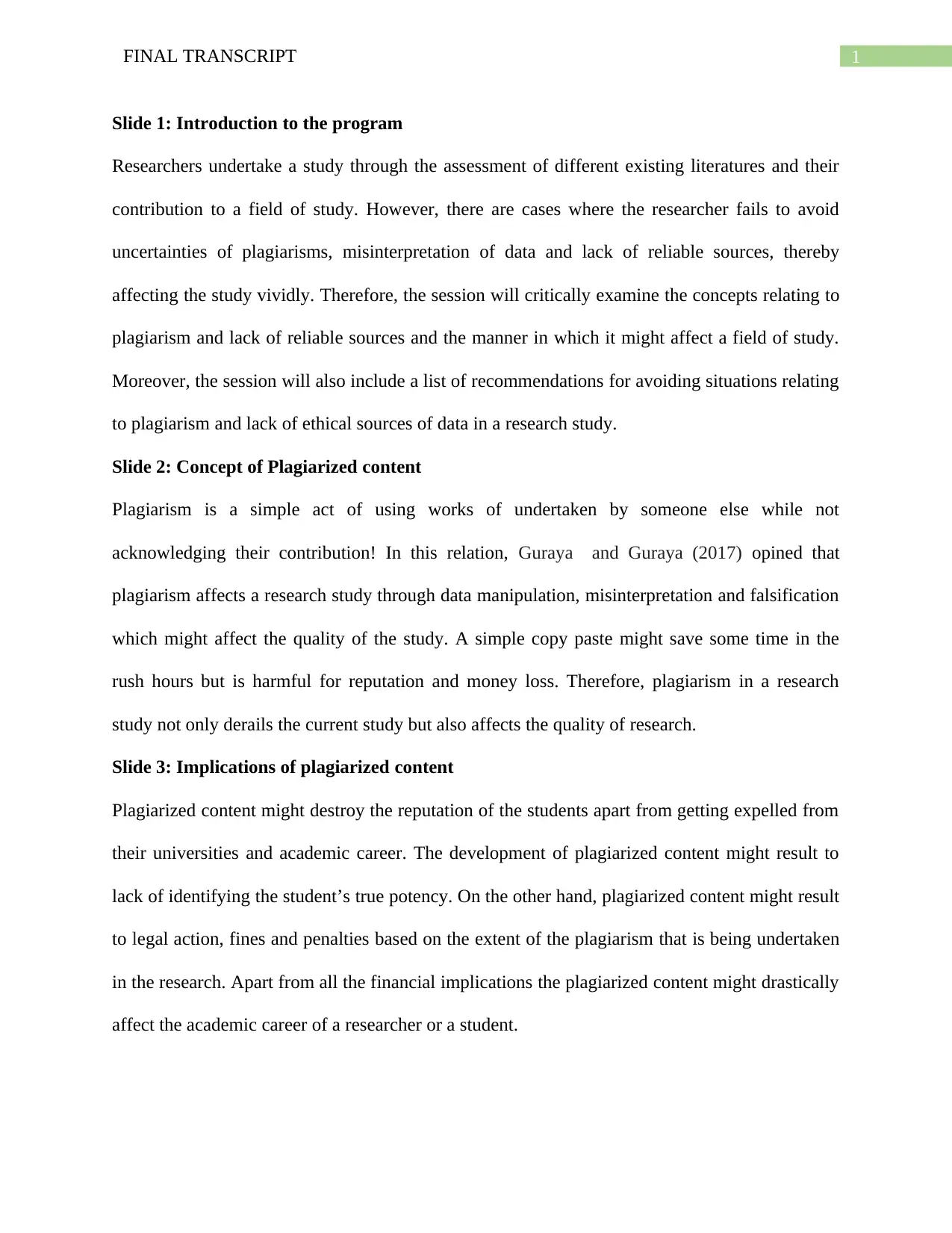
1FINAL TRANSCRIPT
Slide 1: Introduction to the program
Researchers undertake a study through the assessment of different existing literatures and their
contribution to a field of study. However, there are cases where the researcher fails to avoid
uncertainties of plagiarisms, misinterpretation of data and lack of reliable sources, thereby
affecting the study vividly. Therefore, the session will critically examine the concepts relating to
plagiarism and lack of reliable sources and the manner in which it might affect a field of study.
Moreover, the session will also include a list of recommendations for avoiding situations relating
to plagiarism and lack of ethical sources of data in a research study.
Slide 2: Concept of Plagiarized content
Plagiarism is a simple act of using works of undertaken by someone else while not
acknowledging their contribution! In this relation, Guraya and Guraya (2017) opined that
plagiarism affects a research study through data manipulation, misinterpretation and falsification
which might affect the quality of the study. A simple copy paste might save some time in the
rush hours but is harmful for reputation and money loss. Therefore, plagiarism in a research
study not only derails the current study but also affects the quality of research.
Slide 3: Implications of plagiarized content
Plagiarized content might destroy the reputation of the students apart from getting expelled from
their universities and academic career. The development of plagiarized content might result to
lack of identifying the student’s true potency. On the other hand, plagiarized content might result
to legal action, fines and penalties based on the extent of the plagiarism that is being undertaken
in the research. Apart from all the financial implications the plagiarized content might drastically
affect the academic career of a researcher or a student.
Slide 1: Introduction to the program
Researchers undertake a study through the assessment of different existing literatures and their
contribution to a field of study. However, there are cases where the researcher fails to avoid
uncertainties of plagiarisms, misinterpretation of data and lack of reliable sources, thereby
affecting the study vividly. Therefore, the session will critically examine the concepts relating to
plagiarism and lack of reliable sources and the manner in which it might affect a field of study.
Moreover, the session will also include a list of recommendations for avoiding situations relating
to plagiarism and lack of ethical sources of data in a research study.
Slide 2: Concept of Plagiarized content
Plagiarism is a simple act of using works of undertaken by someone else while not
acknowledging their contribution! In this relation, Guraya and Guraya (2017) opined that
plagiarism affects a research study through data manipulation, misinterpretation and falsification
which might affect the quality of the study. A simple copy paste might save some time in the
rush hours but is harmful for reputation and money loss. Therefore, plagiarism in a research
study not only derails the current study but also affects the quality of research.
Slide 3: Implications of plagiarized content
Plagiarized content might destroy the reputation of the students apart from getting expelled from
their universities and academic career. The development of plagiarized content might result to
lack of identifying the student’s true potency. On the other hand, plagiarized content might result
to legal action, fines and penalties based on the extent of the plagiarism that is being undertaken
in the research. Apart from all the financial implications the plagiarized content might drastically
affect the academic career of a researcher or a student.
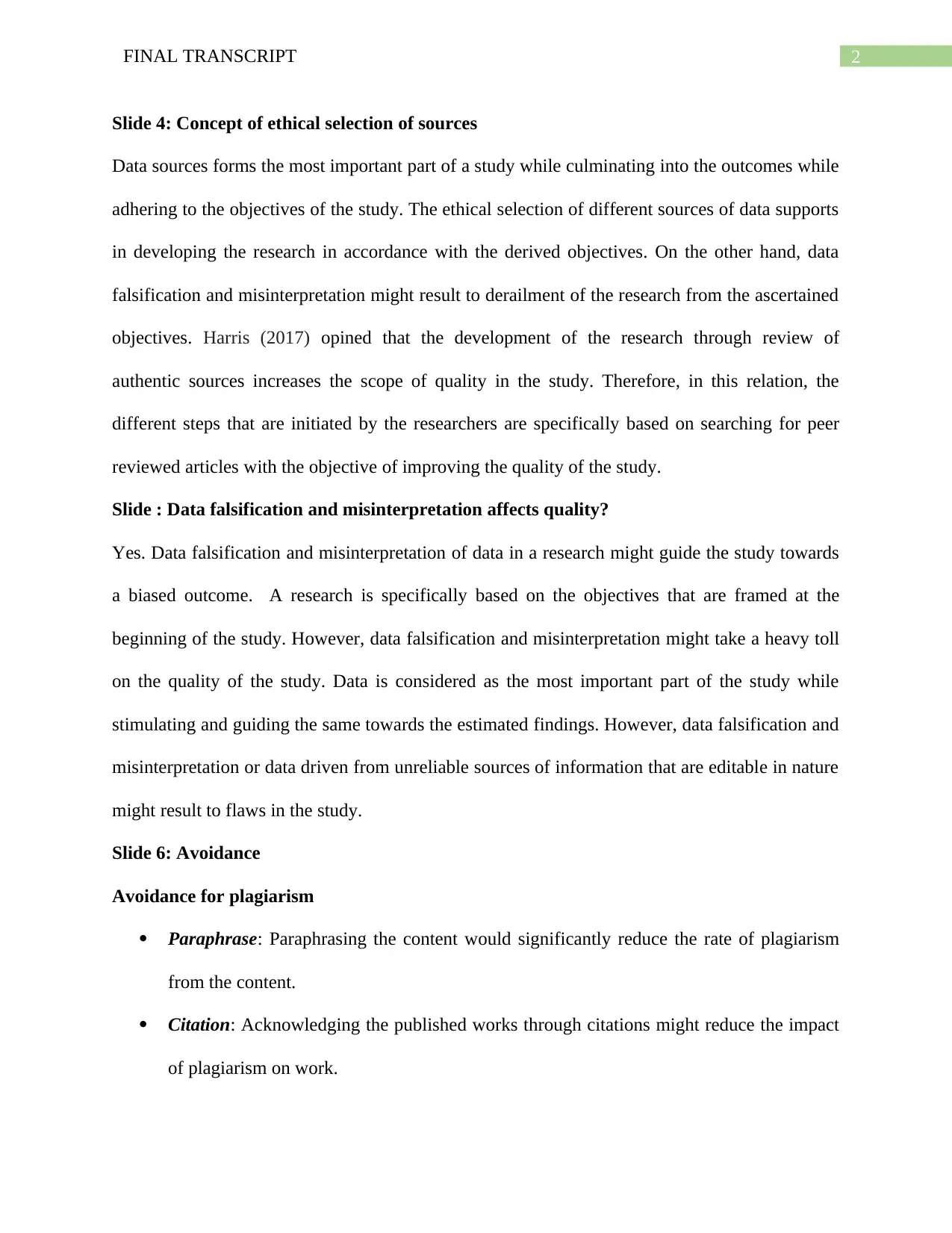
2FINAL TRANSCRIPT
Slide 4: Concept of ethical selection of sources
Data sources forms the most important part of a study while culminating into the outcomes while
adhering to the objectives of the study. The ethical selection of different sources of data supports
in developing the research in accordance with the derived objectives. On the other hand, data
falsification and misinterpretation might result to derailment of the research from the ascertained
objectives. Harris (2017) opined that the development of the research through review of
authentic sources increases the scope of quality in the study. Therefore, in this relation, the
different steps that are initiated by the researchers are specifically based on searching for peer
reviewed articles with the objective of improving the quality of the study.
Slide : Data falsification and misinterpretation affects quality?
Yes. Data falsification and misinterpretation of data in a research might guide the study towards
a biased outcome. A research is specifically based on the objectives that are framed at the
beginning of the study. However, data falsification and misinterpretation might take a heavy toll
on the quality of the study. Data is considered as the most important part of the study while
stimulating and guiding the same towards the estimated findings. However, data falsification and
misinterpretation or data driven from unreliable sources of information that are editable in nature
might result to flaws in the study.
Slide 6: Avoidance
Avoidance for plagiarism
Paraphrase: Paraphrasing the content would significantly reduce the rate of plagiarism
from the content.
Citation: Acknowledging the published works through citations might reduce the impact
of plagiarism on work.
Slide 4: Concept of ethical selection of sources
Data sources forms the most important part of a study while culminating into the outcomes while
adhering to the objectives of the study. The ethical selection of different sources of data supports
in developing the research in accordance with the derived objectives. On the other hand, data
falsification and misinterpretation might result to derailment of the research from the ascertained
objectives. Harris (2017) opined that the development of the research through review of
authentic sources increases the scope of quality in the study. Therefore, in this relation, the
different steps that are initiated by the researchers are specifically based on searching for peer
reviewed articles with the objective of improving the quality of the study.
Slide : Data falsification and misinterpretation affects quality?
Yes. Data falsification and misinterpretation of data in a research might guide the study towards
a biased outcome. A research is specifically based on the objectives that are framed at the
beginning of the study. However, data falsification and misinterpretation might take a heavy toll
on the quality of the study. Data is considered as the most important part of the study while
stimulating and guiding the same towards the estimated findings. However, data falsification and
misinterpretation or data driven from unreliable sources of information that are editable in nature
might result to flaws in the study.
Slide 6: Avoidance
Avoidance for plagiarism
Paraphrase: Paraphrasing the content would significantly reduce the rate of plagiarism
from the content.
Citation: Acknowledging the published works through citations might reduce the impact
of plagiarism on work.
⊘ This is a preview!⊘
Do you want full access?
Subscribe today to unlock all pages.

Trusted by 1+ million students worldwide
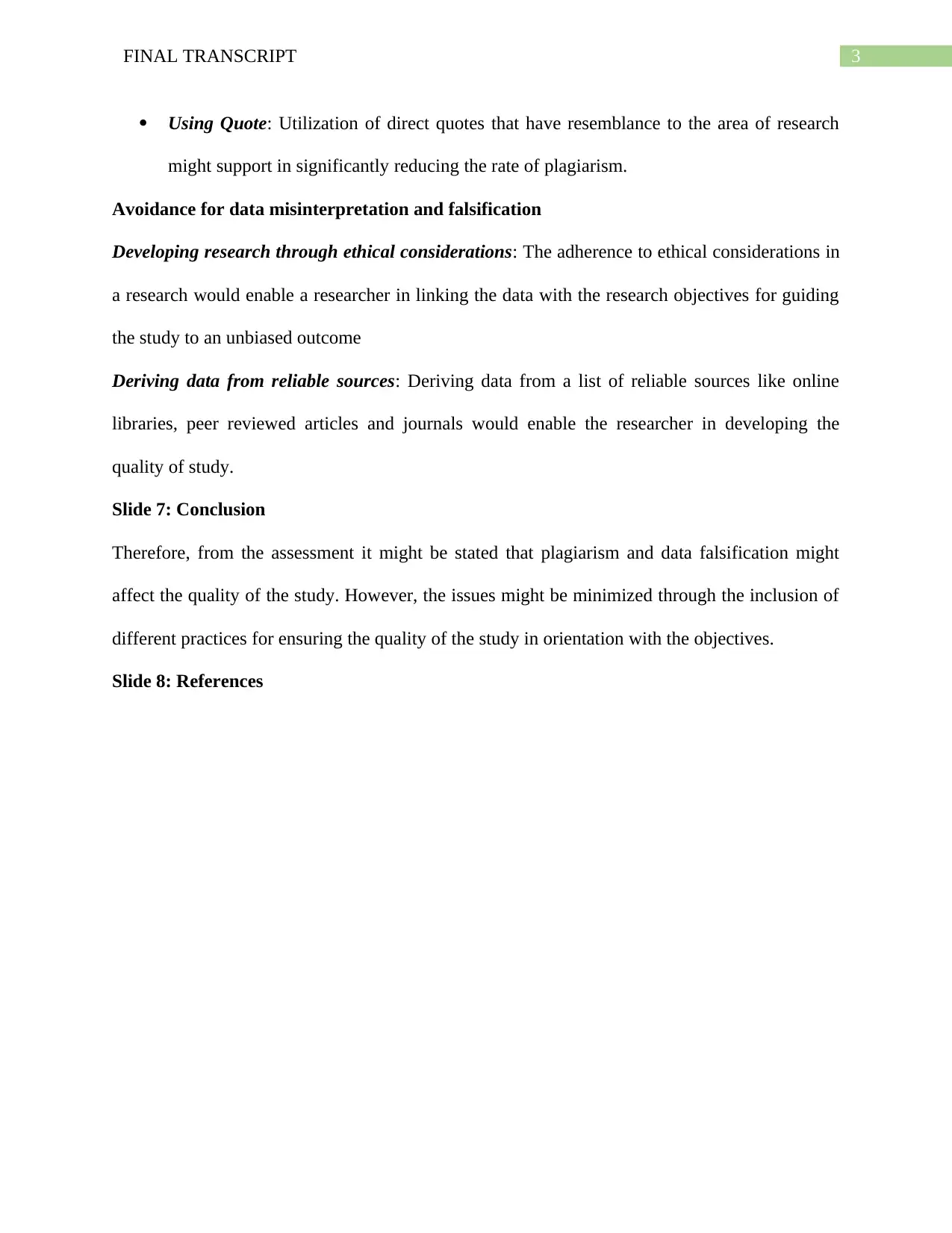
3FINAL TRANSCRIPT
Using Quote: Utilization of direct quotes that have resemblance to the area of research
might support in significantly reducing the rate of plagiarism.
Avoidance for data misinterpretation and falsification
Developing research through ethical considerations: The adherence to ethical considerations in
a research would enable a researcher in linking the data with the research objectives for guiding
the study to an unbiased outcome
Deriving data from reliable sources: Deriving data from a list of reliable sources like online
libraries, peer reviewed articles and journals would enable the researcher in developing the
quality of study.
Slide 7: Conclusion
Therefore, from the assessment it might be stated that plagiarism and data falsification might
affect the quality of the study. However, the issues might be minimized through the inclusion of
different practices for ensuring the quality of the study in orientation with the objectives.
Slide 8: References
Using Quote: Utilization of direct quotes that have resemblance to the area of research
might support in significantly reducing the rate of plagiarism.
Avoidance for data misinterpretation and falsification
Developing research through ethical considerations: The adherence to ethical considerations in
a research would enable a researcher in linking the data with the research objectives for guiding
the study to an unbiased outcome
Deriving data from reliable sources: Deriving data from a list of reliable sources like online
libraries, peer reviewed articles and journals would enable the researcher in developing the
quality of study.
Slide 7: Conclusion
Therefore, from the assessment it might be stated that plagiarism and data falsification might
affect the quality of the study. However, the issues might be minimized through the inclusion of
different practices for ensuring the quality of the study in orientation with the objectives.
Slide 8: References
Paraphrase This Document
Need a fresh take? Get an instant paraphrase of this document with our AI Paraphraser
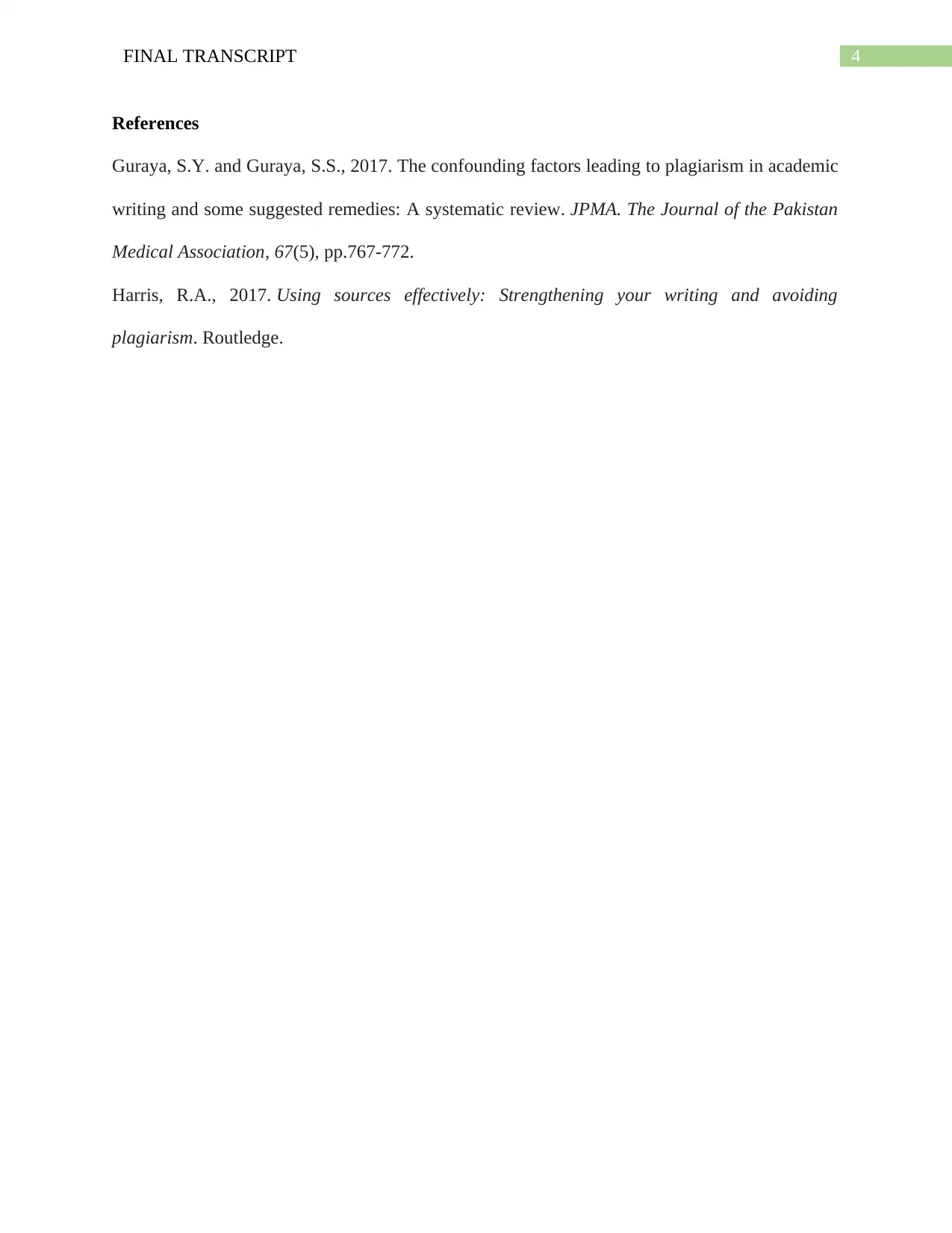
4FINAL TRANSCRIPT
References
Guraya, S.Y. and Guraya, S.S., 2017. The confounding factors leading to plagiarism in academic
writing and some suggested remedies: A systematic review. JPMA. The Journal of the Pakistan
Medical Association, 67(5), pp.767-772.
Harris, R.A., 2017. Using sources effectively: Strengthening your writing and avoiding
plagiarism. Routledge.
References
Guraya, S.Y. and Guraya, S.S., 2017. The confounding factors leading to plagiarism in academic
writing and some suggested remedies: A systematic review. JPMA. The Journal of the Pakistan
Medical Association, 67(5), pp.767-772.
Harris, R.A., 2017. Using sources effectively: Strengthening your writing and avoiding
plagiarism. Routledge.
1 out of 5
Related Documents
Your All-in-One AI-Powered Toolkit for Academic Success.
+13062052269
info@desklib.com
Available 24*7 on WhatsApp / Email
![[object Object]](/_next/static/media/star-bottom.7253800d.svg)
Unlock your academic potential
Copyright © 2020–2025 A2Z Services. All Rights Reserved. Developed and managed by ZUCOL.




